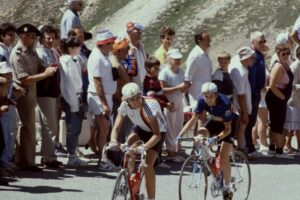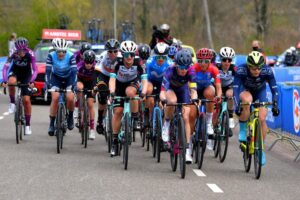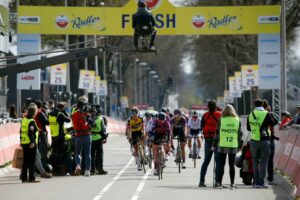The Tour de France Femmes Started In Paris On Sunday
While we all wait for the Netflix TdF documentary to be finished, Joe Lindsey wonders if the Tour de France Femmes should be included.
When the 2022 Tour de France men’s peloton swept into Paris on July 24, all eyes will were on the Champs-Elysées, as always. Which rider will take home the coveted yellow jersey? Who will win the sprint on the prestigious final stage? Among the hundreds of media crews trained on the action will be one of particular interest: the group filming footage of eight teams, including top overall contender Jonas Vingegaard and his team Jumbo-Visma, for the highly anticipated Tour de France documentary series that will debut next winter on Netflix.
But on that day, something even more historic will take place: the start of the inaugural Tour de France Femmes, which succeeds the La Course by Tour de France one-day race and marks the return of a multi-stage women’s Tour de France for the first time in over 30 years. And the Netflix cameras will miss it.
Hold on. You might be saying, “Wait, what? Netflix is doing a Tour de France documentary? Cool!” Yes, they are, and yes, it is. Last March, the giant streaming service greenlit a project around the Tour de France, which was quickly compared to Netflix’s sleeper hit series on Formula One, Drive to Survive, now in its fourth season.
The as-yet unnamed Tour de France series has been filming with eight participating teams at training camps and races all spring and summer, and is booked for eight episodes, with a planned premiere date of early 2023. While two-time defending men’s Tour de France champion Tadej Pogačar and his team UAE Team Emirates are conspicuously missing from those participating, there will still be plenty of star power; top riders like Mathieu van der Poel of Alpecin-Fenix, Jumbo-Visma’s Vingegaard, Primoz Roglič, and Wout van Aert, and INEOS Grenadiers’s Egan Bernal and Tom Pidcock should all be featured characters.
While several of those teams, including Jumbo-Visma and EF Education-EasyPost, have both men’s and women’s rosters, the press release made no mention of the women’s side of the sport. Netflix declined Bicycling’s interview request and did not respond to a follow-up question on whether the series would cover women’s racing. Quad Group and Box to Box Films, the two production companies behind the project, did not respond to requests for comment either.
If, as expected, the series focuses on the men’s peloton only, that’s a monumental missed opportunity, for both women cyclists and the fans who would watch if only they were included.
Iris Slappendel, a former pro and now executive director of The Cyclists’ Alliance, the union for pro women cyclists, wasn’t available for an interview but did send a statement in response to Bicycling’s questions: “It’s great to see men’s cycling receive the spotlight,” it said. “However, it’s disappointing to see it does not appear to unify a storyline on both the men’s and women’s Tour de France.”
This July is the 109th running of the men’s Tour de France, which has been held every year since 1903, except during the World Wars; even the pandemic could only delay the 2020 edition. The first-ever Tour de France Femmes, by contrast, is a major chapter in the start-stop story of the long, unglamorous work to build women’s racing into something sustainable.
 World champion Diana Žiliūtė at the 1999 Women’s Challenge.
World champion Diana Žiliūtė at the 1999 Women’s Challenge.
© James F. Perry, CC BY-SA 3.0, via Wikimedia Commons
Women have been riding and racing bikes pretty much as long as there have been bikes. But for decades, they’ve done so against a headwind of sexism, both casual and intentional. If the advances of 1984—the year of the first Olympic events for women, the first Tour de France Féminin, and the rise of the Ore-Ida Women’s Challenge stage race—suggested that equality was on the horizon, the later demise of the Tour de France Féminin and the Women’s Challenge showed progress could be reversed. Even today, some promoters of top women’s events suggest that they’re “forced” to promote the races out of political correctness.
And yet, in spite of decades of women being told they were unathletic or too frail to race; of racers subjected to physical and emotional abuse that continues even today; of pauper’s wages and a lack of development support; of criticism that women’s racing is boring to watch, here we are, on the cusp of a women’s Tour de France, albeit one with eight stages, not 21 like the men.
“We have to celebrate victories of progress,” said Kathryn Bertine, an activist, filmmaker, and former pro cyclist who helped spur the creation of La Course, the Tour de France Femmes’s most recent predecessor. “And we also have to keep pushing for the progress that has not come.”
The story of that fight, the past battles lost and won, and the work yet to do is a helluva subject for a documentary, as Bertine well knows; she produced and directed 2014’s Half the Road, the last and—as far as she knows—only full-length documentary on women’s road racing. (The documentary Uphill Climb, which focuses on the six-year run of the Tour de France Féminin in the 80s, is currently in production by director Jill Yesko.) But it doesn’t appear that the narrative arc of women’s racing will be part of Netflix’s story.
 Riders racing up the Col De L’Izoard at the 1986 Tour de France Féminin.
Riders racing up the Col De L’Izoard at the 1986 Tour de France Féminin.
Aside from the historical arc, a series on women’s racing would almost certainly benefit from stronger interest from the teams themselves. As word grew of a possible Tour de France documentary, media attention in cycling focused on whether UAE Team Emirates and other top teams would participate, a decision which—for UAE Team Emirates at least—seems mostly to have come down to the fact that team staff were concerned about the distraction the film crews would add to Pogačar’s season. That team—backed by the sovereign wealth of the United Arab Emirates—isn’t motivated by the same interests as many other teams.
Even some teams that are participating seem to view it almost as a favor; Quick-Step manager Patrick Lefevere, never one to hold back, wrote in his regular column in the newspaper Het Nieuwsblad that the project paid “peanuts” and said he had reservations about being part of it. While the reported up-front sum—$50,000 per team, with possible revenue sharing if it does well—is small, a pro cycling team’s business model is generally built on generating media exposure for sponsors. It’s hard to believe women’s teams wouldn’t jump at the eyeballs a platform the size of Netflix could potentially provide.
And if Netflix did turn their cameras on the women’s peloton, what would they find? Stories. Tons of stories: of athletic prowess, yes, and of grit and perseverance, and dreams achieved and dashed. But they’d also find character depth and diversity that, quite honestly, men’s racing doesn’t have to nearly the same degree—perversely because women have had to work so hard, individually and collectively, to get to this point in the sport.
“Many women have juggled studies, work, and family alongside their racing career,” Slappendel noted in her statement, responsibilities many male pros don’t deal with. “The [women’s] peloton is full of diverse and rich stories just waiting to be told.”
Without the same development resources as men’s racing, women have to fight harder to reach the top of the sport. There’s no silver lining to injustice, but it makes for some fascinating backstory to the racing. How did Kristen Faulkner of BikeExchange-Jayco go from being a varsity rower at Harvard to balancing both a venture capital job and a bike that, in one rain-slicked corner, cruelly cost her June’s Tour de Suisse? Movistar’s Annemiek van Vleuten, one of the most talented racers of her generation, has a master’s degree in epidemiology, a topic that’s been front of mind for many for two and a half years now. Erica Magnaldi of UAE-ADQ, a solid stage racer in her own right, not only plans to be a doctor after her racing career ends, she already has her medical degree. And so on.
It’s not that there are no male racers who followed untraditional paths to the sport, or who complement their athletic talents with intellectual ones. It’s that in women’s racing it’s the norm, not the exception.
And if Netflix told those stories, they might reach an audience that is only beginning to be tapped. When the Tour series was announced, several commenters noted similarities to Drive to Survive. And one of that series’s signal successes was boosting interest in F1 racing in two coveted groups: women and younger viewers. Formula One, of course, is an entirely male sport; there are currently no women drivers on the circuit. But that’s not a restriction in cycling, and it’s easy to imagine that a series focused on women cyclists could even more effectively invigorate the sport with a younger, more diverse audience.
It’s not only women who would watch. “There’s no reason we can’t ultimately aim for the same audience as men’s cycling,” said Ina-Yoko Teutenberg, one of the winningest racers in the sport and now sports director for Trek-Segafredo. And Bertine noted that crowdfunding for Half the Road showed backers were equally split between men and women. In short: people who watch men’s racing now increasingly watch women’s racing.
Ratings bear that out. Women’s racing has not been livestreamed for more than a handful of years, so you have to take audience growth numbers with a grain of salt. But Daam van Reeth, an economics professor at Katholieke Universiteit Leuven in Belgium, closely follows the business of sports on television and notes that not only are ratings for women’s races rising fast, audience size is, too. Last year’s women’s Amstel Gold Race, for instance, had a higher share and average audience size in the Netherlands than the men’s edition.
 The 2021 women’s Amstel Gold Race.
The 2021 women’s Amstel Gold Race.
Luc ClaessenGetty Images
A documentary series would not, of course, solve the various issues facing women’s racing. Team budgets, minimum salaries, and prize money all lag well behind the men’s peloton. The Women’s WorldTour calendar—which has only existed since 2016—is already in need of reorganization (much as the men’s).
Maybe the most pressing priority is to improve existing coverage. UCI regulations require Women’s WorldTour stage races to provide at least 45 minutes of live daily coverage, well below what media partners voluntarily devote to men’s racing. But some events don’t even meet that low bar; at the recent RideLondon Classique, organizers livestreamed the last day only, prompting riders like Brodie Chapman to openly call out the race’s failure.
A documentary, said Teutenberg, “is a useful tool to grow the potential audience of women’s cycling, but first, we need frequent and accessible live coverage of races, the more the better.”
After decades of being an afterthought in bike racing, women racers are understandably wary of repeating the patterns, and dysfunctions, of the men’s side of the sport, by tempting potential fans with a product they can’t watch. “We need to be patient and not go too fast right now,” said Trek-Segafredo’s Lucinda Brand, whose canny final-stage racing won her the Tour de Suisse over Faulkner. Her concern—voiced spontaneously—was shared by everyone else who spoke for this article. To them, getting frozen out of the documentary is another example of the sexism in the sport, but parity from Netflix is a lesser concern than improving live race coverage.
 The 2021 women’s Amstel Gold Race was broadcasted with great success.
The 2021 women’s Amstel Gold Race was broadcasted with great success.
PoolGetty Images
That said, a documentary offers a kind of coverage that’s qualitatively different from, and complementary to, livestreaming of races. “Fans need heroines to cheer for,” wrote Slappendel, “but they can’t cheer for a heroine they know nothing about.”
Successful sports documentaries, noted Bertine, are never just about sports. “They’re about the human interest behind the athleticism,” she said, the connection and personal investment in the characters we meet. And absolutely, a single documentary can create long-lasting impressions about a topic. She cited Bryan Fogel’s Oscar-winning movie Icarus, which transformed popular understanding of sports doping and corruption in the Olympic movement, thanks largely to characters like Grigory Rodchenkov, the courageous Russian scientist who blew the whistle on Russia’s state-sponsored cover-up of doping at the 2014 Winter Olympics.
Whether coverage is live or packaged as a documentary, what’s needed most is for women to not be treated as an afterthought. Bertine said the omission from Netflix reminded her of an episode with the Tour of Utah when she was filming Half the Road in 2013. Bertine was working on an article for VeloNews about how the race was seven days for men but a single, 45-minute criterium for women. And she had a hunch about why. “I reached out to the Larry H. Miller car group (the race’s title sponsor) and their lead people in marketing and said, ‘Was the idea of a women’s race pitched to you?’ and they said no, (initially) they had no idea there was women’s racing.”
The Netflix situation struck her as similar. She wondered: Did the pitch deck on the Netflix series mention women’s racing, or was the streaming giant presented a project exclusively focused on the men’s peloton? Was Dolores Emile, the woman who runs Netflix’s non-fiction content for Europe, even told that there was a new women’s Tour de France this year?
Because Netflix declined to comment or make Emile available for an interview, it’s impossible to know. Which raises an interesting question. Much like UAE Team Emirates’s decision not to participate in the Tour de France documentary, season one of Drive to Survive didn’t feature the biggest teams in Formula One, which might have doomed it to a short run. It was the success of the series that got it renewed.
So instead of a singular documentary around both sides of the sport, said Slappendel, “Perhaps the men’s Tour de France documentary is a test case for Netflix to demonstrate that cycling content can drive broader appeal.” If season one proves there’s an audience for bike racing, maybe we can look forward to a season two that swaps Lefevere and Fabio Jakobsen for Teutenberg and Brand, where we hear Cecilie Uttrup Ludwig’s irrepressible post-race interviews and get to know rising stars like Blanka Vas, Shirin van Anrooij, and Veronica Ewers.
Instead of sharing the stage, maybe the women will get it all to themselves.
READ MORE ON: tour de france 2022 tour de france femmes Women in Cycling



